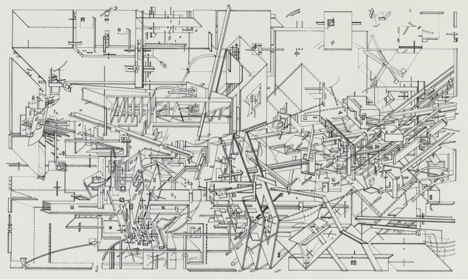[9] The Architectural Dance of Daniel Libeskind’s Micromegas

“Well,” said Micromégas, “maybe the inhabitants of this planet are not of good sense!
But in the end it looks like this may be for a reason. Everything appears irregular
to you here, you say, because everything on Saturn and Jupiter is drawn in
straight lines. This might be the reason that you are a bit puzzled here.
Have I not told you that I have continually noticed variety in my travels?”
—Voltaire2
1
Somewhere beneath thought (malformed, vague, and wildly iterated), in the moment when spoken words or made images give it sound or physicality across a flattened page, somewhere, the idea still bounces around. When the artist’s hand scratches at the paper or the stone with his tools (chisels and pens) and marks on it, what would your first question be, if you were allowed to ask one? “Oh,” someone says, “that’s easy! Are they connected, I’d ask, that disarray in your mind and the scratches your hand makes?” No design is ever fully realized. Look, now, at the drawing above. At first it suggests a plan or blueprint for something to be built, but looking closer you can see beams and cornices that begin and end nowhere. The connections that might make some whole are missing; there are only clues, hints, and suggestions, someone might say, false starts and the merest beginnings of going nowhere. Ideas start up, only to peter out, to be forgotten in the sense of a thought in two dimensions straining to be three. The line dances off the end of the pen; the line in materiality shows what the glimpse of an idea might be like—fractured, irregular, and insufficient.
this all ended up
in the inventory of disuse
your architecture
was empty. “you were making
models to the very end.”
all architecture
remains allegorical
no design is ever
fully made. the idea of space
only between the broken lines
lines aping ideas
non-existent, shapeless, bland
behind whose pictures
of painted bowls, her smiling
eyes disappeared in a blur
2
A blue lamp was fastened to the male dancers’ left wrists, red ones on their right wrists; then blue lamps to their right ankles, and red ones on their left. The overhead lights were switched off in the room and, as the guitarist and the singer began their song in the dark, the dancers ran across the stage, leaping high in the air. Some landed in a crouch, others rolled over on the floor, still others sprang in a twirling motion upwards, arms tightly wrapped around their chests, and then outstretched. The lights traced the moving spider web of thin red and blue contrails in the dark, twisting around one another like silk ribbons in the wind. The lines of light written in the darkness seem to have substance for a second, but, then, so quickly, they are only memories that remain of coiling red and blue creases, how they faded and went out like meteors or sparks rising from a fire.
dream architectures
become lawless, no line needs
end up anywhere
no idea begun, but runs
itself out, suddenly stops
waiting carries on
despite expecting it to
find its own limit
say, “go ahead, see what you
can do; stop when it seems right”
go dance the patterns
in a Persian rug, wallpaper
or the fireplace flames
how pens dance on the page
an architecture of sorts
3
There is a focus in formal art, whether poetry, painting, dance, music, or the plastic arts, a still place from which all the gestures originate and, as if from a catapult, pivot out into the fullness of the work. The resulting integrity and stability of form is something that artist and reader, listener and viewer can recognize and embrace, completing the circuit where artist’s intention and viewer’s expectation meld. But nothing lasts forever; it is inevitable that curiosity, impatience, envy, imagination, and perversity (most often among artists but also among spectators) arise to break with the established forms, wonder about something different, and see unexpected possibilities. Then the focus shifts. Expectations of resemblance, perspective, harmony, rhythm and rhyme, plot, action, and climax are overturned. The center shudders and gives way to energies from the periphery.
you can’t help but wonder
how they thought this one up, moves
so irregular
an elbow out, the leg up
quick, encircling, draws a line
each line of dialogue
stops mid-sense, the poetry
always hurrying
all the colors runs headlong
musical phrases shatter
when it’s always new
what’s next is unexpected
keeps you interested
wide awake and sitting up
so, how did they think of that?
Bio: Charles D. Tarlton
